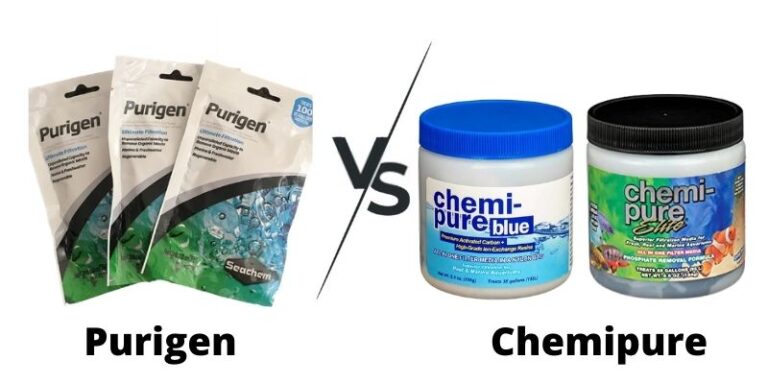Best Saltwater Plants: Top 10 Plants For Saltwater Aquarium
Plants and plant-like macroalgae are the most important component of any saltwater aquarium.
They increase the tank’s beauty and play a pivotal role in maintaining levels of nitrates in the water. Aquarium plants are very easy to handle. They require not very strict caring measures than other sessile organisms like Corals, Anemones, and Sponges.
They also regulate nitrates level and do not let trouble1some microalgae grow by using up the nitrates first and not leaving anything for microalgae, causing them not to propagate. Below are the best saltwater plants for your aquarium and having several benefits.
Many species like to hang around the vegetation, and many take shelter around them when threatened.
Many herbivorous and omnivorous fishes graze on these plants for balancing the nutrition apart from the timely feeding from the tank owner.
10 Best Saltwater Plants List
Long story short, plants are a vital part of both reef and non-reef aquariums regardless of the tank inhabitants. We have compiled a list of the 10 best plants for your saltwater aquarium that will make your tank look great.
Of course, you don’t want to add all of them to the tank at once, but the list will give you an idea for setting up your next saltwater tank project. Let’s look at the list first before getting into the description of what these plants have to offer for your tank.
- Blue Hypnea Algae
- Mermaid’s Fan
- Halimeda
- Turtle Grass shoots
- Green Finger Algae
- Red Mangrove Propagule
- Sea lettuce
- Spaghetti Algae
- Tufted Joint Algae
1. Blue Hypnea Algae
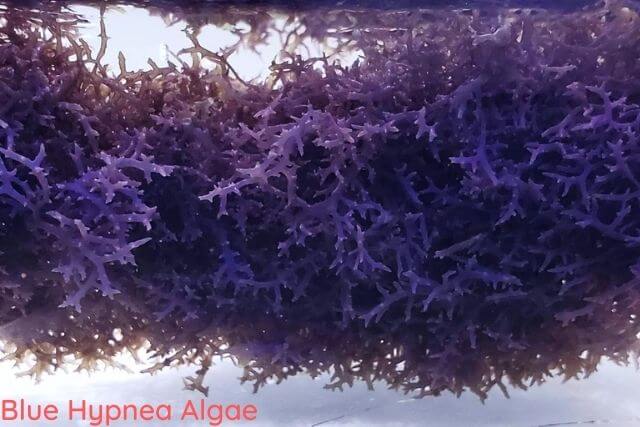
The Blue Hypnea is one of the most valuable macroalgae types used in saltwater aquariums, mostly for decoration purposes.
Although herbivorous fishes can also be grazed, their growth rate is too slow to be compatible with their evergreen nutritional needs. Otherwise, without any doubt, it’s a great ornamental piece for reef aquariums.
It is the subspecies of red macroalgae and can be grown in the main tank, sump and refugium. Its description is concerned and it grows in packed clusters or clumps loosely attached to the rough substratum.
It is iridescent, which means it has fantastic glowing qualities with sparking blue-green coloration, which showcase best in intense lightings.
It is also known as Hypnea pannosa algae. The fishes mostly ignore it, but that’s not all the time. Herbivores will surely graze on them.
Blue Hypnea is an efficient purifier in small aquariums and is best suited for ornamental purposes in large aquariums.
It removes nutrients but cannot be entirely relied on for this purpose owing to its slow growth rate. Iodine is an important growth factor for Blue Hypnea. The precise addition of iodine supplements will help them grow best.
2. Mermaid’s Fan

The Mermaid’s Fan plant is a stiff green type of algae commonly dispersed all across the Caribbean. It is stiff because of the accumulation of limestone in its tissues.
Overall it has a short stem-like structure that bears a blade or fan-like superior structure resembling a compact leaf blade, which is calcified. The stem needs a thick substratum of sand for anchorage.
It is also slow-growing algae and is more of a decorative appeal for the tank than the fishes’ cuisine, though few (and only a few) herbivorous fishes would still rasp on it.
It is almost uneatable because of calcified tissues, thus a safe inclusion in the tank containing vegetarian inhabitants.
Mermaid’s Fan is not sensitive to nitrates and phosphorus levels as much as other macro-algal species are and therefore must be grown in a tank with little bio-load pressures.
It can easily be outgrown by the competitive types of microalgae that grow on top of it in nutrient-rich water. This is the reason it is best to keep in less crowded saltwater tanks. Lightings and adequate amounts of calcium are very important for its growth.
3. Halimeda
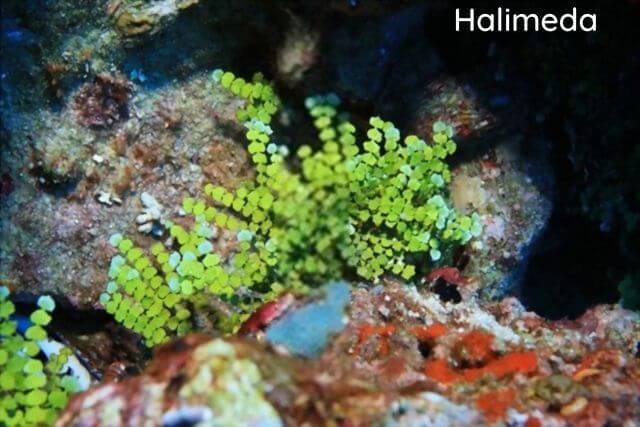
Plant Halimeda species is also commonly known as the Money plant. It is also a type of calcified macroalgae that is mostly found growing along the reefs in tropical marine waters worldwide.
They are known as money plants because of their coin-shaped leaflets stacked upon each other by connecting from end to end, forming a string. It can be grown on the sandy bottom as well as on the live rock.
It is renowned for its decorative demands for almost all reef aquariums, and yes, it does best when grown in reef aquariums. Halimeda species are generally thought of as non-invasive and hardy in the right conditions.
Still, they are not much resistive to the levels of nitrates, unlike many other macro-algal species. Only a few herbivorous fishes feed on them as well.
It is not tolerant to substantial trimming or pruning, and it puts permanent damage to its re-growing capacity.
The money plant acts as a powerful indicator of sufficient calcium levels to support coral growths in the reef aquariums. They grow best along the side of the corals because of having similar requirements of water conditions.
4. Turtle Grass Shoots
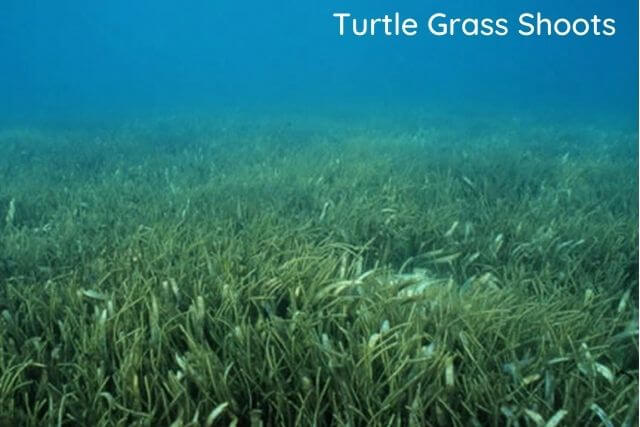
The Turtle Grass shoots is another macro-algal species most commonly found in its native Florida Gulf Coast range. It also goes by the common name of Maiden’s hair plant.
It is not a calcareous plant but certainly contains some toxins, making it uneatable for herbivorous species. But some species like Yellow tangs and Turbo snails still feed on it. It is seaweed, which grows only up to 3 inches making it highly suitable for carpeting of the tank.
Turtle Grass is used for decorative purposes and to make the best out of them. You need to provide them with intense lighting and strong water currents.
It’s not always possible to keep the lighting conditions intense as fish’s requirements in the tank also need to be kept in mind. But this is not something to be worried about as it will still grow and survive.
It is a hardy type of macroalgae and requires a moderate level of care. It provides a suitable surface for the reception of the eggs of tank inhabitants. Turtle Grass shoots plant is generally reef safe, but the toxins produced by it can kill the nearby corals.
This happens mainly when it comes as a pest on a raw or unprocessed live rock. Its requirements for the nutrients include trace elements and mostly iron, which it gets from the tank water nutrients.
5. Green Finger Algae
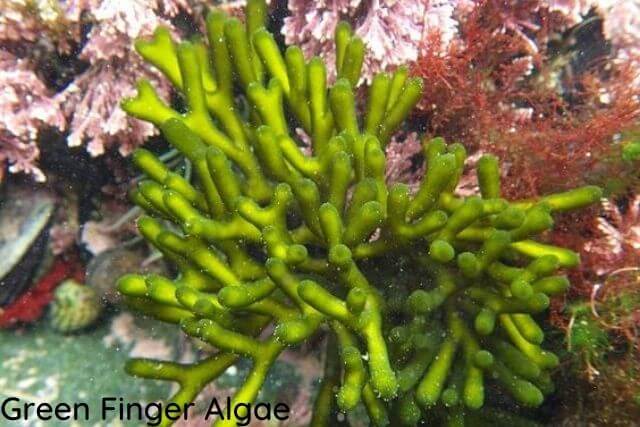
The Green Finger algae is an incredible macro algae type that shows irregular dichotomous or ‘Y’ shaped branching patterns. It is extensively grown in the saltwater aquarium for its aesthetic benefits and is also considered one of the best saltwater plants.
It is named as green finger plant because of these finger-like dichotomous projections projecting out from a central surface.
Green finger algae plant is not something that the fishes will eat, but the soft branches that originate from filaments do offer herbivorous to nip on them.
It comes in the unattached form, and you can place it somewhere around the rock formation to let it anchor itself or add some Zoa cones to provide it a suitable attachment.
Green-Finger-Plant is very flexible in lighting needs but will perform best in the upper-middle range of light intensity. You must trim to the light green soft portion of the filament as it may indicate the decomposition.
As mentioned earlier, it is almost uneatable and, therefore, more aesthetic in the tank’s aqua scaping.
It is a beautiful macroalgae and is very efficient in maintaining the water quality at its best by helping in nutrient export and regulating the water’s oxygenation. With its spreading type of branching, it can grow up to 3 inches of elongation.
6. Red Mangrove Propagule
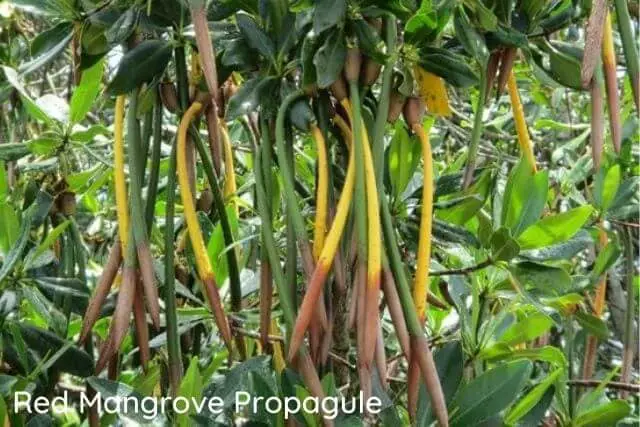
The Red Mangrove is a spectacular plant of intertidal zones of tropical oceans. It is also trendy in aqua scaping of the saltwater as well as freshwater aquariums. It is an elongated plant that can grow up to 8 to 10 inches in length or even more.
The Red Mangrove is best sold in the form of propagules and is planted in groups. The propagule is an independent germinating part of the plant which develops roots when given an appropriate anchorage.
It is usually grown in the aquariums, housing those species, which are not swift jumpers because its leaves are kept outside the water surface. It is also being sold in less expensive tubers, which are very laborious to sprout or germinate.
Germinating their seeds can also be done, but this is not a common practice. Growing these plants in the tank will give your tank a bamboo-like forested appearance.
It is hardy and acts as a strong equalizer in maintaining water quality due to its quality of equalizing nitrates and phosphate levels in the water. Thus it is an efficient nutrient controller of an aquarium.
All the unwanted nutrients that it absorbs are accumulated in its leaves. Therefore the leaves must immediately be removed upon falling in the tank to prevent them from decaying. The caring measures include trimming every two weeks.
7. Sea lettuce
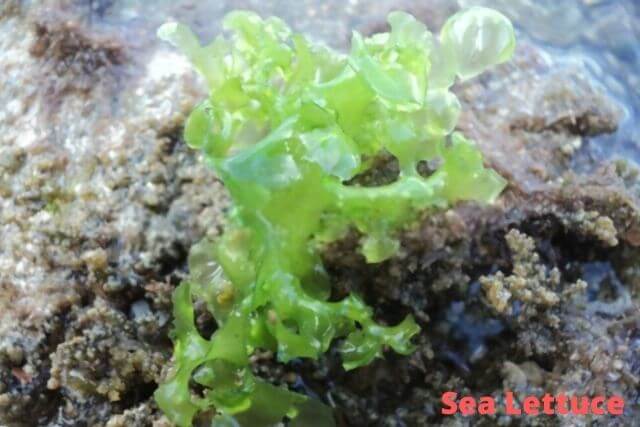
Plant Sea lettuce is an extensively growing type of macro algae naturally encountered in intertidal zones and shallow-water coastal areas.
This algae’s growth rate is kept in check by the harsh conditions of wind and temperature and the grazers that come with the tides. Its ability to take up the nutrients and maintain water quality is a widespread macroalga to grow in aquariums.
It does not offer any toxic production to the fishes that make it the most delicious cuisine for almost all the herbivorous tank inhabitants. This is the primary reason it is not encouraging to grow in the tank hosting the herbivorous fishes as they can graze it out within no time.
Otherwise, it is an excellent addition to the aquariums as a nutrient controller. It gives the tank a naturally wild look and hosts various small organisms like copepods, amphipods, and other tiny crustaceans.
It is famous for its rapid growth rate. The more space it is provided with, the more it will spread. It usually grows as long as just 3 inches and spreads extensively.
It stores all the absorbed nutrients, and you can take it out of the system only when it is harvested.
The best use of freshly harvested sea lettuce is to reintroduce it as for aquarium food, and it is common practice as well, but it strictly depends on the types of tank inhabitants.
8. Spaghetti Algae
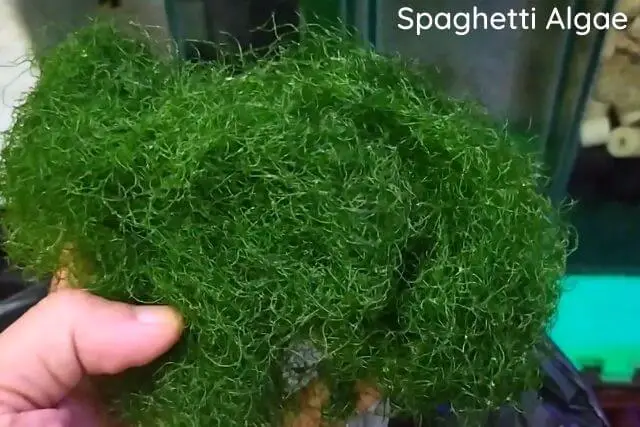
It is commonly known as Green Hair Algae. Spaghetti Algae is an excellent macroalgal species famous for its efficient nutrient controlling ability. As its name suggests, it grows in hair-like condensed clumps resembling many perplexed threads or fishing line.
Small herbivorous species usually leave these algae alone, but the larger species such as Tangs, Rabbitfish, and Angels graze on it. Ideally, it would be best if you grew it in non-vegetarian tanks.
It houses organisms like copepods, amphipods, and other small crustaceans as well. Spaghetti Algae does not require any specific substratum and can grow on the live rocks efficiently.
It can also freely float in water. Many people prefer to grow it in a separate refugium. It needs strong water currents and intense lighting in the refugium to water cleaning by controlling nutrients.
It grows rapidly and requires iron and other trace elements in a nutrient-deprived aquarium. Iron supplements can prove to be dangerous if mismanaged. Iron can trigger undesirable microalgae to grow. Therefore, reasonable, caring measures are necessary for doing so.
9. Tufted Joint Algae
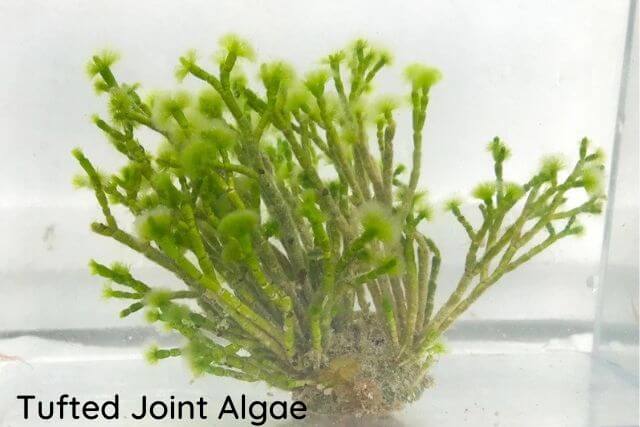
The Tufted joint Algae is another ornamental macroalgal species that is very common for decoration purposes. It is very striking, owing to which aquarists refrain from growing it in aquariums inhabiting vegetarians.
It has a branching type of growth pattern where each branch or trunk composes small segments, giving it a tree-like appearance. Tiny hairy structures project at the end of each segment and make a tuft resembling leaves.
Intense bright light and strong water currents are required to grow rapidly, which is very important, inefficient water cleaning and oxygenation performed by these macroalgae.
Its care requirements are moderate, and the presence of nutrients and trace elements make it grow well.
10. Red Gracilaria
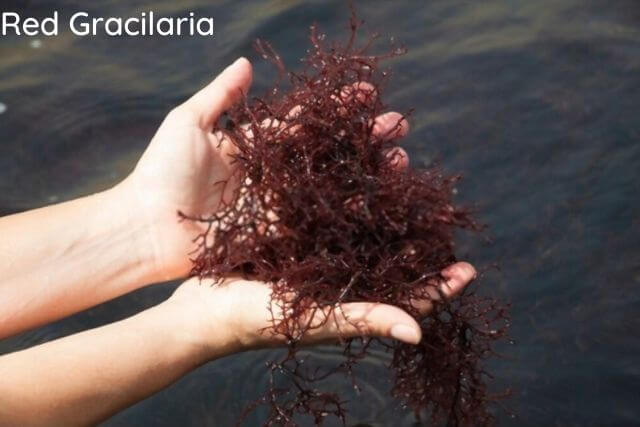
The plant Red Gracilaria is a reddish macroalgae. Apart from the aquarium trade, it is one of the most popular marine veg cuisines in several parts of the world.
The abundant red pigments dominate the green pigment giving it a reddish appearance that is more prominent in UV light.
It can take roots if grown between or on the live rock and makes terrific additions, especially in the reef aquariums.
Owing to its extraordinary growth potential, it can combat the grazing of small herbivorous fishes. But the larger species such as tangs don’t leave the piece of it behind.
It is not a very efficient controller of phosphate and nitrates, especially in high amounts. Moderately strong lighting and water flow are necessary for its optimum growth.
Other nutrients essential for its growth are magnesium, iron, and trace other elements, but supplementation in control is much more important.
Why Do You Need Plants In The Aquarium?
The plants are the fundamental component of any aquarium. Many fish species are shy and timid, and they like to hang around dense vegetation. For such species, plants provide hiding places and shelter to sleep at night.
How To Clean The Old Fish Tank – A Complete Tank Cleaning Guide
Plants help fishes spawn and breed by providing a sense of security and offering the surfaces for the reception of fertilized eggs.
No matter what kind of fish or inverts you have got in your tank, the plants would be an excellent replica of their natural habitat and make them feel at home.
Moreover, we all know that herbivorous fishes eat plants, and with that in mind, you can let your fish get the most balanced nutrition by putting some of their most-liked submerged salad.
The plants could be ornamental or live. Ornamental plants are useful for decoration purposes, but the live plants account for the maintenance of oxygen levels of the water.
They maintain water quality as well by consuming Carbon dioxide and nitrates. Macroalgae and plants do not let the invasive type microalgae increase in the tank.
Both microalgae and macroalgae use nitrates, but in the food web, macroalgae consume the nitrates first, leaving very scarce or nothing for microalgae to feed.
How To Choose The Best One For Yourself
Aquascaping is a great practice that has been taking new forms over the years, and enthusiasts do it in an artistic way to recreate their tank project’s natural outlook.
The addition and maintenance of plants in saltwater aquariums are not as easy as it is for freshwater tanks. The reason behind this is the salinity and the intensity of biomass produced in the saltwater tanks.
The Question that every startup hobbyist comes up with is choosing the right plants for his saltwater tank that adds to the tank’s overall beauty and keeps the water quality optimally maintained.
Saltwater is prone to quick intoxication as the saltwater animals produce more bio-load than freshwater animals.
The plants or macroalgae which are efficient in nutrient control without showing a negative impact on their growth rate are the best for any saltwater aquarium provided the tank does not inhabit vegetarians, which tend to impose threats for their survival. Listed and described above are the few best saltwater plants chosen by the experts.
Can You Put Live Plants In A Saltwater Aquarium?
You can easily put any live plants having the requirements as per the saltwater aquarium. Halimeda, Spaghetti Algae, and Red Gracilaria plants are the best if you want to put live plants in your saltwater aquarium.
Floating Saltwater Plants
There are some plants out there that do not need any substratum or surface to anchor themselves. Instead, they float, and this is how they thrive.
They may still have thread-like roots anchoring loosely to some rock, but mostly they are not anchored. They have a main leafy body that floats on the water’s surface to get the maximum exposure to light.
Due to continuous and massive tidings, the ocean water is not suitable for the floating type of flora. Still, certain species like two brown algae species, i.e., Sargassum natans and Sargassum fluitans, are typical examples of marine floating plants.
